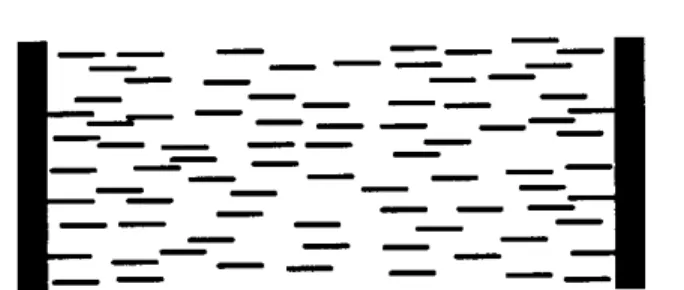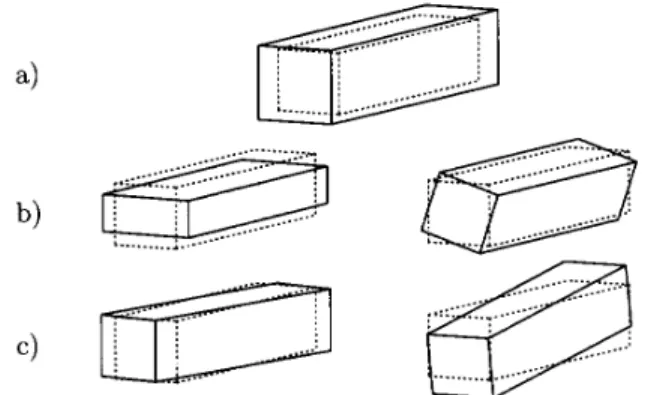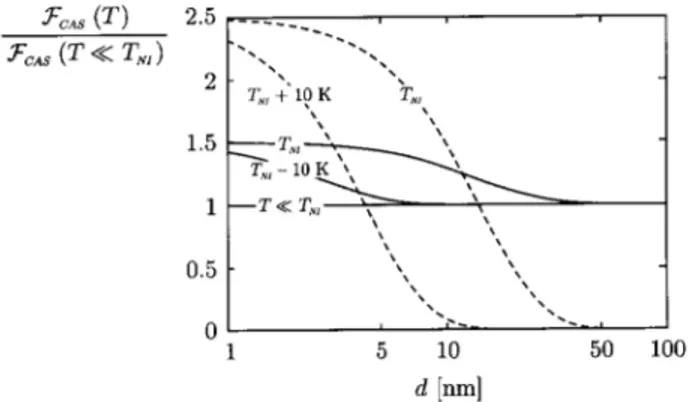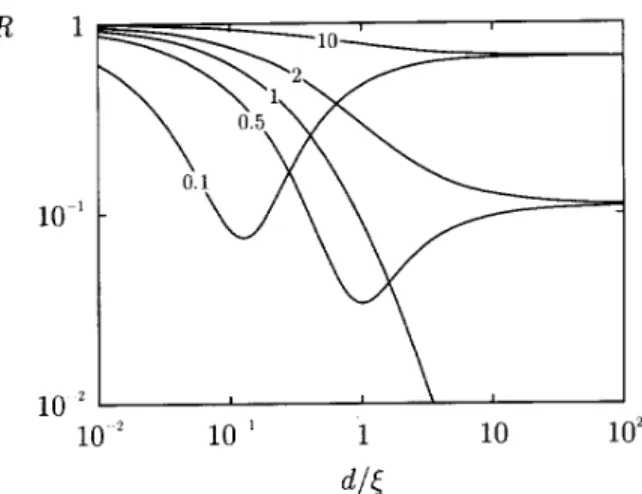Fluctuation-Induced Structural Forces
in Nematic Films
P. Ziherl, S. Zumer, and R. Podgornik
J. Stefan Institute, Jamova 39, 1000 Ljubljana, Slovenia and
Department of Physics, University of Ljubljana, Jadranska 19, 1000 Ljubljana, Slovenia
Received29October,1998
In a brief review of the theory of pseudo-Casimir interaction in nematic liquid crystals, we describe long- and short-range uctuation-induced forces in these materials and discuss the role of the anchoring strength in this context. We also analyze the pretransitional behavior of the interaction in the vicinity of the clearing point.
PACS numbers: 61.30.-v, 61.30.Gd, 61.30.Cz
I Introduction
The discovery of polymer dispersed liquid crystals in the eighties [1] has put the liquid crystal display tech-nology in a new perspective. Since then, the classical design of a display cell based on a liquid-crystalline ma-terial sandwiched between two transparent electrodes has been complemented by a device consisting of a com-posite material, e.g., a dispersion of micron-size liquid-crystalline droplets in a solid polymer matrix. The undisputed advantages of this concept in some electro-optical applications have boosted the research in the eld of microconned liquid crystals, which has evolved into one of the most vivid branches of the liquid crystal science.
The interest in the physics of severely conned sys-tems has raised a number of both experimental and the-oretical issues which did not seem very important in the past. One of them has to do with the mechanical sta-bility of such systems, which is invariably related to the structural interaction mediated by the liquid-crystalline material. Were liquid crystals perfect, disordered liq-uids, they would give rise to the van der Waals force only. But they are orientationally ordered rather than structureless, and this results in an additional interac-tion between the walls of the host medium, which is induced by the liquid crystal itself.
The experimental studies of the structural force in
liquid crystals are typically carried out by a surface force apparatus [2, 3, 4, 5], and in general they have been found to be consistent with the mean-eld model of the interaction. However, there are also indications that the mean-eld description of the systems studied may not be entirely adequate and that the uctuation-induced force could play a detectable role [5].
Until the beginning of this decade, there was no ex-plicit interest in uctuation-induced force between solid objects immersed in liquid crystals, although its mech-anism | the Casimir eect | has been well-known for half a century [6]. In the rst theoretical study of the phenomenon, the long-range force due to thermal uctuations of the order parameter in nematic, smec-tic, and columnar phase has been calculated [7, 8], and these results constitute the skeleton of the theory of the pseudo-Casimir interaction in liquid crystals.
and outline some of the open problems in the eld.
II Long-range force
Deep in the nematic phase, the most important param-eter of the orientational liquid-crystalline order is the
average direction of the molecules described by the di-rector eld n(r). The energetic cost of deformation of
the director eld is given by the Frank elastic energy
c
H V[
n(r)] = 12 Z
h K
11( rn)
2
+K 22(
nrn) 2
+K 33(
nrn) 2
i
dV; (1)
d
whereK 11
;K 22and
K
33are the splay, twist, and bend
elastic constant [9]. The coupling between the orien-tation of material and the conning substrates is de-scribed by the anchoring energy, which is usually mod-eled by the Rapini{Papoular ansatz
H S[
n(r)] =,
1 2
Z
G(nk) 2
dS; (2)
where G is the anchoring strength and k is the
pre-ferred orientation of the director eld at the substrate, the so-called easy axis. The total Hamiltonian is, of course, a sum of the bulk and the surface contribution:
H[n(r)] =H V[
n(r)] +H S[
n(r)].
Let us now assume that the nematic sample consid-ered is bounded by two parallel identical plates sepa-rated byd(Fig. 1). In this case the equilibrium
cong-uration of the director eld,n
0, is uniform, because the
preferred orientations of nat the two plates coincide.
The mean-eld free energyF MF =
H[n
0] is equal to 0,
which implies that the corresponding thermodynamic force dened by
F MF =
,
@F MF @d
V;S
(3)
also vanishes. This exemplies the main property of all mean-eld forces: they occur only in geometries char-acterized by a competition between surface-induced or-der and bulk oror-der | or, more precisely, by a deformed equilibrium conguration that results from this frustra-tion.
Figure 1. The system considered consists of two identical parallel plates immersed in a nematic liquid crystal.
The uctuation-induced forces, on the other hand, are present in every conned geometry, no matter whether the equilibrium conguration of the liquid-crystalline (or any other) system is uniform or not. The uctuation-induced forces result from the bound-ary conditions imposed by the substrates, which modify the spectrum of collective uctuations. The free energy of constrained uctuations between the substrates is dierent from the free energy of uctuations in an un-constrained surrounding medium, and this gives rise to a net interaction of the substrates.
How does one calculate the interaction free energy? The free energy of the thermally excited uctuations around the mean-eld state,n, is determined by their
partition function. Within the classical statistical me-chanics, the partition function of the uctuating direc-tor eld is given by the functional integral over all con-gurations ofnthat satisfy the boundary conditions
exp(,F CAS
=kT) = Z
D(n)exp(,H[n]=kT); (4)
where k is the Boltzmann constant and T is the
and of the interaction free energy, which is dened sim-ply as the residuum.
A detailed discussion of the methods of calculation of the partition function is beyond the scope of this re-view. At this point, we shall merely quote the result in the strong anchoring limit, which means that the uc-tuations of the director eld must vanish at the two plates. In this case the uctuation-induced interaction free energy is given by
F CAS=
,
(3)kTS
16d 2
K
33 K
11
+K 33 K
22
; (5)
where S is the area of each of the plates and
is the Riemann zeta function, (3) being equal to
1:20205690:::[7, 8]. The corresponding force reads
F CAS =
,
(3)kTS
8d 3
K
33 K
11
+K 33 K
22
: (6)
This attractive long-range force represents the dom-inant part of the pseudo-Casimir eect in nematic phase, and is completely analogous to the high-temperature limit of the electromagnetic Casimir in-teraction. Apart from the factor that accounts for the elastic anisotropy of the liquid crystal and clearly iden-tied the contributions of splay-bend and twist-bend modes, the amplitude of the interaction is universal, and the Boltzmann factor witnesses the thermal ori-gin of the force. This result was subsequently extended to account for the ruggedness of the interacting sur-face [11, 12].
III Short-range force
The above discussion gives an outline of the most im-portant manifestation of the pseudo-Casimir eect in
the nematic phase, which results from director uctu-ations. However, the true nematic order parameter is an irreducible second-rank tensor rather than a head-less vectorn, and accomodates the degrees of order and
biaxiality and the orientation of the secondary director on top of the orientation of the director itself (Fig. 2). Unlike the director modes, the three additional com-ponents of the order parameter do not arise from the broken continuous symmetry of the nematic phase and their Hamiltonians are not purely elastic.
Figure 2. The ve nematic degrees of freedom can be vi-sualized by a block such that the anisotropy of its sides is proportional to the eigenvalues of the order parameter. Fluctuations of the degree of order are represented by the breathing mode (a), biaxial uctuations modify the ratio of the short sides and rotate the block about its long axis (b), and director uctuations correspond to the rotation of the block about the two short axes (c).
The nondirector degrees of freedom are most im-portant in the vicinity of the nematic-isotropic phase transition, which is | at the phenomenological level | usually described by the Landau{de Gennes theory. The cornerstone of the Landau{de Gennes approach is the (truncated) Taylor expansion of the free energy den-sity in terms of scalar invariants of the order parameter
Q(r), which is usually given by c
h V = 12
A(T,T )tr
Q 2
,
1 3BtrQ
3
+ 14C ,
trQ 2
2
+ 12LrQ...rQ; (7)
d
whereA;B;C, andLare material constants,T is the
supercooling temperature. As implied by the presence of a single deformational term [which corresponds to the one-elastic-constant approximation of the Frank
Hamil-tonian, Eq. (1)] the details of the liquid-crystalline elas-ticity are not essential in the vicinity of the phase tran-sition. The elastic constant,L, is proportional to the
of the degree of order. | In a similar fashion, the Rapini{Papoular anchoring energy density can be gen-eralized to
h S =
L
2
tr(Q,Q 0)
2
; (8)
whereis the so-called extrapolation length which
con-trols the strength of the anchoring, and Q
0 is the
pre-ferred value of the tensorial order parameter at the sub-strate.
In a suitable base, the above formalism reduces to the analysis of ve uncoupled scalar degrees of free-dom [13]. In the uniaxial nematic phase the analysis is even simpler, because the two biaxial modes are de-generate and so are the two director modes. In the one-elastic constant approximation, the generic form of the Hamiltonian that covers all ve degrees of freedom [here denoted byb(r)] reads
c
H[b(r)] = L
2
Z
(rb) 2+ ,2 b 2
dV + ,1 Z b 2d S ; (9)
where is the temperature-dependent correlation length characteristic of a particular type of uctuations. In the
case of uctuations of the degree of order, is given by
No= 0 9 4
1 +p
1,8=9
p
1,8=9 ,1=2 ; (10) d where 0 = p 27LC=B 2
10 nm is the bare
corre-lation length1, and
is the reduced temperature such
that = 0 corresponds to the supercooling limit and = 1 corresponds to the phase transition temperature.
The correlation length of the biaxial uctuations reads
Nb = 0 27 4
1 +p
1,8=9
,1=2
; (11)
whereas the correlation length of the director modes | the broken symmetry variable of the nematic order | is, of course, innite.
This Hamiltonian also applies to director uctua-tions in an external electric or magnetic eld: by di-viding the uctuations into splay-bend and twist-bend modes, the vectorial Hamiltonian [Eq. 1] can be split
into two uncoupled partial Hamiltonians, each operat-ing on a scalar eld. In this case, stands for
elec-tric or magnetic coherence length, p
2K = a 0 E 2 and p 2 0 K = a B 2 (where
K is the elastic constant, and a
and
a are the anisotropies of the dielectric
permittiv-ity and of the magnetic susceptibilpermittiv-ity, respectively) [9]. Moreover, the same Hamiltonian also describes uctu-ations in the isotropic phase, where all ve modes are degenerate and their correlation length is given by
I = 0 ,1=2 : (12)
With the Hamiltonian spelled out, we can calculate the interaction free energy. Again, we will just give the result [14] which reads
c F CAS= kTS 8 2 Z 1 0 ln 0 @1 , p ,2+ q 2 , ,1 p ,2+ q 2+ ,1 ! 2 exp ,2 p ,2+ q 2 d 1 A
qdq; (13)
1The meaning of the bare correlation length becomes clear as soon as
= 1 is substituted in Eqs. (10) and (12):
0 is the value of
and is analogous to the screened van der Waals inter-action between two semiinnite dielectrics separated by an electrolyte [15]. In the following, the most important aspects of this interaction will be discussed briey.
Let us rst nd out how a nite correlation length changes the uctuation-induced interaction! Assume that the anchoring is strong, i.e., = 0, and that d . In this case, the uctuation-induced force is
short-range:
F CAS =
, kTS
4 2
d
exp(,2d=); (14)
which corresponds to the interaction induced by the three non-director modes in the nematic phase (and also by the director modes in an external aligning eld) and by the uctuations in the isotropic phase. The other limit,d, recovers either splay-bend or
twist-bend mode contribution to the long-range interaction [Eq. (6)] within the one-elastic-constant approximation,
,(3)kTS=8d 3.
Figure 3. Pretransitional behavior of the uctuation-induced force in a nematic liquid crystal is depicted most transparently by plotting the ratio of the temperature-dependent total uctuation-induced force and the director modes' force. On approaching TNI from the nematic phase
(solid line), the range of the short-range component of the uctuation-induced force increases and in typical materials it reaches 10 nm at the clearing point. In the isotropic
phase (dashed line), the uctuation-induced force is entirely short-range and its correlation length decreases on heating.
The interaction free energy [Eq. (13)] describes the continuous crossover from long- to short-range force or vice versa, which occurs, for example, on approaching the nematic-isotropic transition. The overall pretran-sitional amplication of the uctuation-induced force is mainly due the increase of the correlation length of the uctuations of the degree of order, and is most pronounced in materials with small latent heat of the
transition. The pretransitional behavior of the pseudo-Casimir force can be illustrated by plotting the ratio of the total uctuation-induced force and the long-range director modes' force which dominates deep in the ne-matic phase (Fig. 3). On approaching the clearing point from below, the range of the short-range com-ponent of the uctuation-induced structural force in-creases and in typical materials it reaches10 nm at T
NI. In the isotropic phase, the pseudo-Casimir force is
entirely short-range, and its range decreases on heating. Were the transition continuous, at the critical tem-perature the pseudo-Casimir force would be larger by 50% than deep in the nematic phase, because on top of the two director modes that dominate the pseudo-Casimir eect in nematic liquid crystals, there would be an additional degree of freedom | the degree of order | characterized by long-range correlations. However, the nematic-isotropic transition is not continuous, and a signicant temperature variation of the uctuation-induced force could be observed only in the superheated or supercooled regime.
We must stress that the formalism presented is quite general and also applies to other phase transitions, and in most liquid-crystalline materials that exhibit smec-tic C and smecsmec-tic A phase, the transition between the two is actually continuous. In such a case the phase transition is associated with the critical slowdown of the soft mode, and a clear and strong pretransitional amplication of the pseudo-Casimir force is expected.
IV Anchoring
Having analyzed the role of the correlation length in the uctuation-induced interaction, we can proceed with a discussion of the eect of anchoring. The rst impor-tant fact concerning the role of anchoring is quite ob-vious: the prefactor to the exponential in Eq. (13) is equal to 1 both for!0 and for!1, which means
that an innitely weak anchoring gives rise to the same pseudo-Casimir force as an innitely strong anchoring. This is no surprise, since the two limiting cases dier only in the type of the boundary conditions but not in the spectrum of uctuations.
be represented by the reduction factor dened as the ratio of the uctuation-induced force at niteand its
strong-anchoring counterpart:
R(d=;=) = F
CAS( d;;) F
CAS(
d;;= 0)
: (15)
In the case of innite correlation length, which corre-sponds to director modes, R depends only on the
ra-tio d=, and is depicted in Fig. 4. Both for weak
(d= 1) and strong anchoring (d= 1), R
ap-proaches 1, and in between it reaches a minimum of 0.077 at d= = 1:230. It can be shown that for d=1,Ris approximately given by 1,6=d, which
implies that the nite-anchoring-strength correction to the long-ranged
,3-force is proportional to d
,4.
Figure 4. Reduction factor of the interaction induced by the director modes reaches a minimum of 0.077 atd== 1:230.
The asymptotic expansion of R for large d= is given by
1,6=d(dashed line).
If the correlation length of uctuations is nite, R
depends both on d= and =, and may be either a
monotonic or a non-monotonic function of the inter-plate separation (Fig. 5). In case of rather strong an-choring, i.e., for=<1, the reduction factor descends
from 1 to a minimum and then increases to the satu-rated value, whereas for weak anchoring or= >1 it
decreases monotonically. As shown in Fig. 4, the satu-rated value ofR does not change if= is substituted
by =, and for large and small =, R(d= ! 1) is
given by 1,4=and 1,4=, respectively. The fact
that R saturates for larged= implies that
asymptoti-cally the functional form of the short-range interaction remains unchanged and that the anchoring merely re-duces its magnitude. | The case = = 1 is clearly
quite special, and is characterized by a reduction factor
that does not level o at large d='s. It can be shown
that it falls o approximately as 2
=2d
2, so that in this
particular case the uctuation-induced force is given by
,(kTS=8d 3)exp(
,2d=).
Figure 5. Reduction factor for uctuations with nite corre-lation length for== 0:1;0:5;1;2;and 10: in case of rather
strong anchoring, Ris a nonmonotonic function of the
re-duced distance,d=, and in case of rather weak anchoring Rdecreases monotonically towards the larged=limit.
V Fluctuation-induced forces vs.
mean-eld forces
It has been mentioned already that the pseudo-Casimir forces are present in any conned system, whereas the mean-eld interaction only occurs in geometries char-acterized by deformed order parameter eld. In the ne-matic phase, the mean-eld force is largely determined by the distortion of the director induced by nonplanar conning geometry or by the hybridity of the anchor-ing. This interaction is repulsive and roughly propor-tional tod
,2, which means that it dominates in large
systems. In small cavities, on the other hand, pseudo-Casimir interaction should prevail since it is, as shown above, proportional tod
,3.
the case: below a certain void size, it may be energet-ically very costly to distort the director eld and min-imize the anchoring energy, and an undistorted liquid-crystal structure is preferred instead [16]. Uniform di-rector congurations might be rather ubiquitous in sys-tems with characteristic size up to, say, 100 nm | and since the mean-eld elastic interaction is absent in uni-form director congurations, the uctuation-induced stuctural forces are probably more important than it seemed at rst.
This argument brings us to another interesting as-pect of the nematic order in highly constrained liquid crystals. In the vicinity of the nematic-isotropic phase transition temperature, the system can avoid the ener-getic penalty of an unfavorable director orientation at the wall by reducing the degree of order in the subsur-face layer. In other words, the deformation of the direc-tor eld is replaced by the deformation of the prole of the degree of order. This mechanism, which is expected to be most prominent in systems characterized by large anchoring energy, immediately raises the question of uctuation-induced interaction in heterophase liquid-crystalline structures. In a forthcoming paper, we will address this aspect of the pseudo-Casimir eect by an-alyzing the phenomenon in systems characterized by a surface-induced degree of order substantially dierent from the degree of order in the bulk of the sample [17].
VI Conclusions
We have discussed several theoretical aspects of the uctuation-induced interaction in nematic lms and pointed to some of the systems where this interaction is expected to represent an important if not the dominant part of the structural force.
The theory of the pseudo-Casimir force in liquid crystals extends well beyond the topics described in this paper and is still, of course, far from being complete. Some of the most interesting issues in the eld, such as uctuation-induced interaction in prenematic and
pres-mectic systems, distorted nematic structures, polymer liquid crystals, etc., will be addressed in the future.
Acknowledgments
We acknowledge support from Ministry of Science and Technology of Slovenia (project No. J1-0595-1554-98) and European Commission (INCO-Copernicus project No. IC15CT96-0744).
References
[1] J. W. Doane, N. S. Vaz, B.{G. Wu, and S. Zumer, Phys. Rev. Lett.48, 269 (1986).
[2] R. G. Horn, J. N. Israelachvili, and E. Perez, J. Phys. France42, 39 (1981).
[3] L. Moreau, P. Richetti, and P. Barois, Phys. Rev. Lett.
73, 3556 (1994).
[4] P. Richetti, L. Moreau, P. Barois, and P. Kekiche, Phys. Rev. E54, 1749 (1996).
[5] B. D. Swanson and L. B. Sorensen, Phys. Rev. Lett.75,
3293 (1995).
[6] H. B. G. Casimir, Proc. Kon. Ned. Akad. Wet.51, 793
(1948).
[7] A. Ajdari, L. Peliti, and J. Prost, Phys. Rev. Lett.66,
1481 (1991).
[8] A. Ajdari, B. Duplantier, D. Hone, L. Peliti, and J. Prost, J. Phys. II France2, 487 (1992).
[9] P. G. de Gennes and J. Prost, The physics of liquid crystals (Clarendon Press, Oxford, 1993).
[10] P. M. Chaikin and T. C. Lubensky, Principles of con-densed matter physics (Cambridge University Press, Cambridge, 1995).
[11] H. Li and M. Kardar, Phys. Rev. Lett.67, 3275 (1991).
[12] H. Li and M. Kardar, Phys. Rev. A46, 6490 (1992).
[13] E. I. Pokrovskii and E. I. Kats, Zh. Eksp. Teor. Fiz.
73, 774 (1977) [Sov. Phys. JETP 46, 405 (1977)].
[14] P. Ziherl, R. Podgornik, and S. Zumer, Chem. Phys. Lett.295, 99 (1998).
[15] J. Mahanty and B. W. Ninham, Dispersion forces (Aca-demic Press, London, 1975).
[16] O. D. Lavrentovich and P. Paly{Muhoray, Liquid Crystals Today5, 5 (1995).



